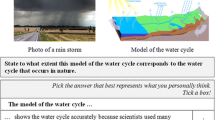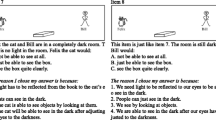Abstract
This study reports on the development and application of a four-tier multiple-choice (4TMC) diagnostic instrument, which has not been reported in the literature. It is an enhanced version of the two-tier multiple-choice (2TMC) test. As in 2TMC tests, its answer and reason tiers measure students’ content knowledge and explanatory knowledge, respectively. The two additional tiers measure the level of confidence of students in the correctness of their chosen options for the answer and reason tiers respectively. The 4TMC diagnostic test focused on the properties and propagation of mechanical waves. It was administered to 598 upper secondary students after they were formally instructed on the foregoing topics. The vast majority of the respondents were found to have an inadequate grasp of the topics tested. Mean scores and mean confidence associated with the answer tier was higher than those associated with the reason tier. The students tended to be poorly discriminating between what they know and what they do not know. Familiarity with the topic tested was associated with greater percentage of students giving correct answers, higher confidence, and better discrimination quotient. Nine genuine alternative conceptions (which were expressed with moderate levels of confidence by students) were identified.
Similar content being viewed by others
Notes
Mainstream schools are non-autonomous and non-independent schools. They follow the curriculum and implement school programmes which are set by the Ministry of Education. They do not offer niche programmes. They admit students solely on the basis of the students’ scores in the Primary School Leaving Examination (PSLE)—a national examination given at the end of Grade Six. (Ministry of Education 2008).
Based on the students’ aggregate scores in the PSLE, students are directed into different streams of academic ability. The stream, in which the present sample belongs, requires aggregate scores of about 50% and above of the maximum score, for eligibility.
References
Al-Rubayea, A. A. M. (1996). An analysis of Saudi Arabia high school students’ misconceptions about physics concepts. Dissertation Abstracts International, 57(04), 1462, (UMI No. 9629018).
Altman, D. G. (1991). Practical statistics for medical research. London: Chapman & Hall.
Barman, C. R., & Barman, S. N. (1996). Two teaching methods and students’ understanding of sound. School Science and Mathematics, 96(2), 63–68.
Clement, J., Brown, D. E., & Zietsman, A. (1989). Not all preconceptions are misconceptions: finding ‘anchoring conceptions’ for grounding instruction on students’ intuition. International Journal of Science Education, 11(5), 554–565. doi:10.1080/0950069890110507.
diSessa, A. A. (1993). Toward an epistemology of physics. Cognition and Instruction, 10(2 & 3), 105–225.
Echternacht, G. J. (1972). The use confidence testing in objective tests. Review of Educational Research, 42–2, 217–236.
Eshach, H., & Schwarz, J. L. (2006). Sound stuff: naïve materialism in middle-school students’ conceptions of sound. International Journal of Science Education, 7(1), 733–764.
Franklin, B. J. (1992). The development and application of a two-tier diagnostic instrument to detect misconceptions in the area of force, heat light and electricity. Dissertation Abstracts International, 53(12), 4186, (UMI No. 9301049).
Glenberg, A. M., & Epstein, W. (1985). Calibration of comprehension. Journal of Experimental Psychology: Learning Memory and Cognition, 11, 702–708.
Glenberg, A. M., Sanocki, T., Epstein, W., & Morris, C. (1987). Enhancing calibration of comprehension. Journal of Experimental Psychology: General, 116, 119–136.
Griffard, P. B., & Wandersee, J. H. (2001). The two-tier instrument on photosynthesis: what does it diagnose? International Journal of Science Education, 23(10), 1039–1052.
Hasan, S., Bagayoko, D., & Kelley, E. L. (1999). Misconceptions and the Certainty of Response Index (CRI). Physics Education, 34(5), 294–299.
Hill, G. D. (1997). Conceptual change through the use of student-generated analogies of photosynthesis and respiration by college non-science majors. Dissertation Abstracts International, 58(06), 2142, (UMI No. 9735480).
Lang, H. G. (1982). Criterion-referenced tests in science: an investigation of reliability, validity and standards-setting. Journal of Research in Science Teaching, 19(8), 665–674.
Linder, C. J. (1993). University physics students’ conceptualizations of factors affecting the speed of sound propagation. International Journal of Science Education, 15(6), 655–662.
Lundeberg, M. A., Fox, P. W., & Punćhochaŕ, J. (1994). Highly confident but wrong: gender differences and similarities in confidence judgments. Journal of Educational Psychology, 86(1), 114–121.
Lundeberg, M. A., Fox, P. W., Brown, A. C., & Elbedour, S. (2000). Cultural influences on confidence: country and gender. Journal of Educational Psychology, 92(1), 152–159.
Maurines, L. (1992). Spontaneous reasoning on the propagation of visible mechanical signals. International Journal of Science Education, 14(3), 279–293.
McKelvie, S. J. (1978). Effects of some variations in rating scale on the means and reliabilities of ratings. British Journal of Psychology, 69, 185–202.
McKelvie, S. (1992). Does memory contaminate test-retest reliability? The Journal of General Psychology, 119(1), 59–72.
Menchen, K. V. P., & Thomson, J. R. (2004). Pre-service teachers’ understanding of propagation and resonance in sound phenomena. In J. Max, S. Franklin, & J. Cummings (Eds.), 2003 Physics education Research Conference (pp. 65–68). New York: American Institute of Physics.
Ministry of Education [MOE] (2008). Independent schools, special assistance plan (SAP) schools, autonomous schools and niche programme schools. http://www.moe.gov.sg/education/admissions/secondary-one-posting/files/secondary-one-posting-english.pdf.
Morris, C. (1990). Retrieval process underlying confidence in comprehension judgments. Journal of Experimental Psychology: Learning Memory and Cognition, 16, 223–232.
Palacios, F. J. P., Cazorla, F. N., & Cervantes, A. (1989). Misconceptions on geometric optics and their association with relevant educational variables. International Journal of Science Education, 11(3), 273–286.
Popham, W. J., & Husek, T. R. (1969). Implications of criterion-referenced measurement. Journal of Educational Measurement, 6(1), 1–9.
Reiner, M., Slotta, J. D., Chi, M. T. H., & Resnick, L. B. (2000). Naïve physics reasoning: a commitment to substance-based conceptions. Cognition and Instruction, 18(1), 1–34.
Reynolds, C. R., Livingston, R. B., & Willson, V. (2006). Measurement and assessment in education. Boston: Pearson.
Stankov, L., & Crawford, J. D. (1997). Self-confidence and performance on test of cognitive abilities. Intelligence, 25(2), 93–109.
Stankov, L., & Dolph, B. (2000). Metacognitive aspects of test-taking and intelligence. Psychologische Beiträge, 42(2), 213–227.
Tobin, K. G., & Capie, W. (1981). The development and validation of a group test of logical thinking. Educational and Psychological Measurement, 11, 413–423.
Treagust, D. F. (1986). Evaluating students’ misconceptions by means of diagnostic multiple-choice items. Research in Science Education, 16, 199–207.
Treagust, D. F. (1988). Development and use of diagnostic tests to evaluate students’ misconceptions in science. International Journal of Science Education, 10, 159–170.
Tsai, C. C., & Chou, C. (2002). Diagnosing students’ alternative conceptions in science. Journal of Computer Assisted Learning, 18, 157–165.
Voska, K. W., & Heikkinen, H. W. (2000). Identification and analysis of student conceptions used to solve chemical equilibrium problems. Journal of Research in Science Teaching, 37(2), 160–176.
Witmann, M. C. (2002). The object coordination class applied to wave pulses: analysing student reasoning in wave physics. International Journal of Science Education, 24(1), 97–118.
Wittmann, M. C., Steinberg, R. N., & Redish, E. F. (1999). Making sense of how students make sense of mechanical waves. The Physics Teacher, 37, 15–21.
Wittmann, M. C., Steinberg, R. N., & Redish, E. F. (2003). Understanding and affecting student reasoning about sound waves. International Journal of Science Education, 25(8), 991–1013.
Zakay, D., & Glicksohn, J. (1992). Overconfidence in a multiple-choice test and its relationship to achievement. Psychological Record, 42(4), 519–525.
Acknowledgment
We thank the Nanyang Technological University for the award of a research scholarship to the first author and a research grant (RI 9/06 RS) to the second author.
Author information
Authors and Affiliations
Corresponding author
Appendix*
Appendix*






Rights and permissions
About this article
Cite this article
Caleon, I.S., Subramaniam, R. Do Students Know What They Know and What They Don’t Know? Using a Four-Tier Diagnostic Test to Assess the Nature of Students’ Alternative Conceptions. Res Sci Educ 40, 313–337 (2010). https://doi.org/10.1007/s11165-009-9122-4
Received:
Accepted:
Published:
Issue Date:
DOI: https://doi.org/10.1007/s11165-009-9122-4




